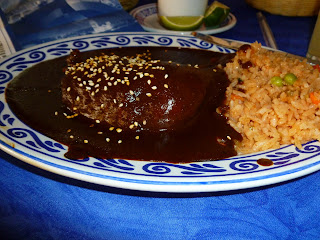Puebla
The trip to Puebla was lovely. After the 'misery zone' as Paco puts it, we passed some beautiful countryside which did actually have some of that golden light. (I had been noticing a flat quality to the light here, which presents ‘just the facts’, and does not burnish or caress what it touches.) Corn in shocks in curvy foothills, piedmont rapidly giving way to shallow volcanoes, not so different from Cville—except the volcanoes. Occasional men, donkeys, carts. Poured concrete seems to be the building material of choice-- or is it slabs poured at a factory and shipped? When someone has time and a little cash, they might paint the walls in varied bright colors. These buildings pour out over the countryside in bleak neighborhoods or climb the mountainsides like in Quito. This kind of building is common in China too, and ugly there, too. Then we went through extensive pine forests, The trees were paraboloid, or hyperboloid to be more precise, and had pom pom tufts of long needles, sometimes looking like giant gumdrops, not at all the tall triangular forms we are used to. They were sparse enough that there was tall grass underneath. The volcanoes were very dramatic, and one was smoking or steaming a bit. But the big one, Popocatopetl, had patches of snow. There were some low strata clouds about two thirds of the way up Popo.
 |
| trees with socks in Puebla |
Puebla itself is a large, sprawling city but the colonial downtown is in a coherent small area. The bus stop was close to the Hostal, which was just a couple of blocks from the Zocalo. The Zocalo was ringed by the cathedral, government buildings, and at ground level, colonnaded cafes and such. It has trees (painted with lime to about four feet from the ground, as if they are wearing socks) and grass and is altogether pleasant; and especially in the evening, maybe because of the holiday is crowded with people. Many are launching lighted toys into the night that have the effect of fireworks, just like one Jacob gave me. Now I know what it is for! I believe the Zocalo is built over ruins of more pyramids or some sort of ancient ruins. Puebla has various local treats including buttery cookies, a sort of pumpkin seed halvah, and pastries with dried fruits. Sweet, sweet, sweet!
 |
| typical dish (mole poblana) on a typical dish |
I successfully found the Fonda Sta Clara, the one Paco recommended. Oddly, it was not where google maps had it, but luckily was on the way. I had seen a street photo on google maps, so recognized it. There was another Sta Clara operation at the pinpointed location. Despite all the Christmas stuff, or maybe because of it, the restaurants are not that busy. Fonda Sta Clara meal:
a gordito is a fat little (3”) pancake with stuff on top: the usual suspects, beans, cheese, beef, salsa.
A chalupa is like a mini tostada-- this one had red sauce not too hot and a little tinga. Which is shredded chicken or beef, tiny shreds.
 |
| Fonda Santa Clara |
A molete is like a savory fried pie about the size of McD's apple pies but with a savory filling. Not on a par with pakoras.
The mole poblano was odd, chocolatey tasting, sweet, rich, not really spicy, with a lot of gloppy sauce . . . odd, to my taste.
Puebla is lovely and looks like a Spanish town or a bit like Cagliari, with stuccoed houses with pastel paints and a certain deep yellow, bougainvillaea, palms, and other trees, taller than in DF; tall rectangular windows with iron grillwork. But also inset tiles mixed with brickwork, and stone doorways; tiny shops tucked into vestibules. They sell snacks like tacos and doner tacos and churros and gorditos, and total junk, but never fresh veggies or fruit like China.
 Buildings are on the courtyard principle, and views inside are a lot like courtyard houses in Beijing—bikes leaning on walls, an old table in the courtyard, miscellaneous junk. Some have beautiful gardeny spaces inside, but some on more industrial streets are filled with broken machinery, tires, and the flotsam and jetsam of a repair or machine shop.
Buildings are on the courtyard principle, and views inside are a lot like courtyard houses in Beijing—bikes leaning on walls, an old table in the courtyard, miscellaneous junk. Some have beautiful gardeny spaces inside, but some on more industrial streets are filled with broken machinery, tires, and the flotsam and jetsam of a repair or machine shop. I have not seen dog or cat one, except for two ladies of a certain age, both sporting leopard print dresses, sitting side by side on a bench. They each had an animal print tote, and from each tote peeped a chihuahua. No one looked happy.
On the left is a wall with panels inset with talavera tiles, a Puebla specialty, a brilliant yellow wall around a church courtyard with bougainvillea spilling over.












